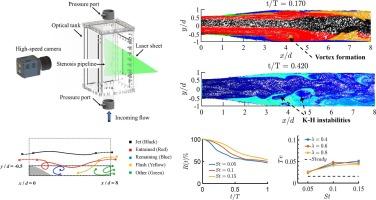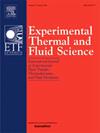Lagrangian analysis of fluid transport in pulsatile post-stenotic flows
IF 2.8
2区 工程技术
Q2 ENGINEERING, MECHANICAL
Experimental Thermal and Fluid Science
Pub Date : 2024-10-28
DOI:10.1016/j.expthermflusci.2024.111342
引用次数: 0
Abstract
A comprehensive experimental study was performed to characterize the fluid transportation processes in pulsatile post-stenotic flows. This study aims to understand the effect of pulsatility on the transportation dynamics of post-stenotic flows and to establish a non-dimensional number to quantify transportation effectiveness in these flows. Two-dimensional particle tracking velocimetry measurements were conducted in a close flow loop with a symmetric stenosis model. A pathline extension algorithm is then applied to the obtained Lagrangian data, such that fluid parcels are continuously tracked as they flow through the region of interest. Pulsatile flows at Reynolds numbers , Strouhal number and amplitude ratio and 0.8 are systematically investigated to understand the influence of pulsatility on the transport and mixing dynamics. The flow structures, such as the formation and evaluation of vortex rings, Kelvin-Helmoltz instabilities, jet meandering and breakdown, are clearly revealed by the lifespan parcel trajectories and the particle residence time (PRT). These structures are closely related to the transportation behaviours of the post-stenotic flows. Using the obtained Lagrangian results, the transportation effectiveness of the post-stenotic flows is further quantified by the depletion efficiency. The results demonstrate that while post-stenotic flows transport most residual fluids under a higher amplitude ratio, the depletion efficiency itself is insensitive to the amplitude ratio. The flow system operates more efficiently with high pulsatile frequencies (). Additionally, a transportation effectiveness parameter, , is defined to evaluate the transport performance by comparing the transportation efficiency to the pressure drop. The value is optimized at a high pulsatile frequency () and a low amplitude ratio (), with being up to twice as high as its counterpart in the steady flow.

脉动后狭窄流体输运的拉格朗日分析
为了描述脉动后狭窄流动中的流体输送过程,我们进行了一项全面的实验研究。这项研究旨在了解脉动性对后狭窄流体输送动力学的影响,并建立一个非维数来量化这些流体中的输送效果。二维粒子跟踪测速仪测量是在具有对称狭窄模型的闭合流环路中进行的。然后将路径线扩展算法应用于获得的拉格朗日数据,从而在流体包裹流经相关区域时对其进行连续跟踪。系统研究了雷诺数 Rem=1000、2000、4000,斯特劳哈尔数 St=0.05、0.1、0.15,振幅比 λ=0.4 和 0.8 的脉动流,以了解脉动性对传输和混合动力学的影响。流动结构,如涡旋环的形成和评估、开尔文-赫尔莫尔茨不稳定性、射流蜿蜒和破裂,通过寿命包裹轨迹和粒子停留时间(PRT)清晰地揭示出来。这些结构与后狭窄流的传输行为密切相关。利用所获得的拉格朗日结果,可以通过耗竭效率进一步量化后狭窄流的输送效果。结果表明,虽然后狭窄流在较高的振幅比下能输送大部分残余流体,但损耗效率本身对振幅比并不敏感。高脉动频率(St=0.8)下的流动系统运行效率更高。此外,还定义了一个传输效率参数 Te,通过比较传输效率和压降来评估传输性能。在高脉动频率(St=0.8)和低振幅比(λ=0.4)条件下,Te 值达到最优,Te 值是稳定流中相应值的两倍。
本文章由计算机程序翻译,如有差异,请以英文原文为准。
求助全文
约1分钟内获得全文
求助全文
来源期刊

Experimental Thermal and Fluid Science
工程技术-工程:机械
CiteScore
6.70
自引率
3.10%
发文量
159
审稿时长
34 days
期刊介绍:
Experimental Thermal and Fluid Science provides a forum for research emphasizing experimental work that enhances fundamental understanding of heat transfer, thermodynamics, and fluid mechanics. In addition to the principal areas of research, the journal covers research results in related fields, including combined heat and mass transfer, flows with phase transition, micro- and nano-scale systems, multiphase flow, combustion, radiative transfer, porous media, cryogenics, turbulence, and novel experimental techniques.
 求助内容:
求助内容: 应助结果提醒方式:
应助结果提醒方式:


